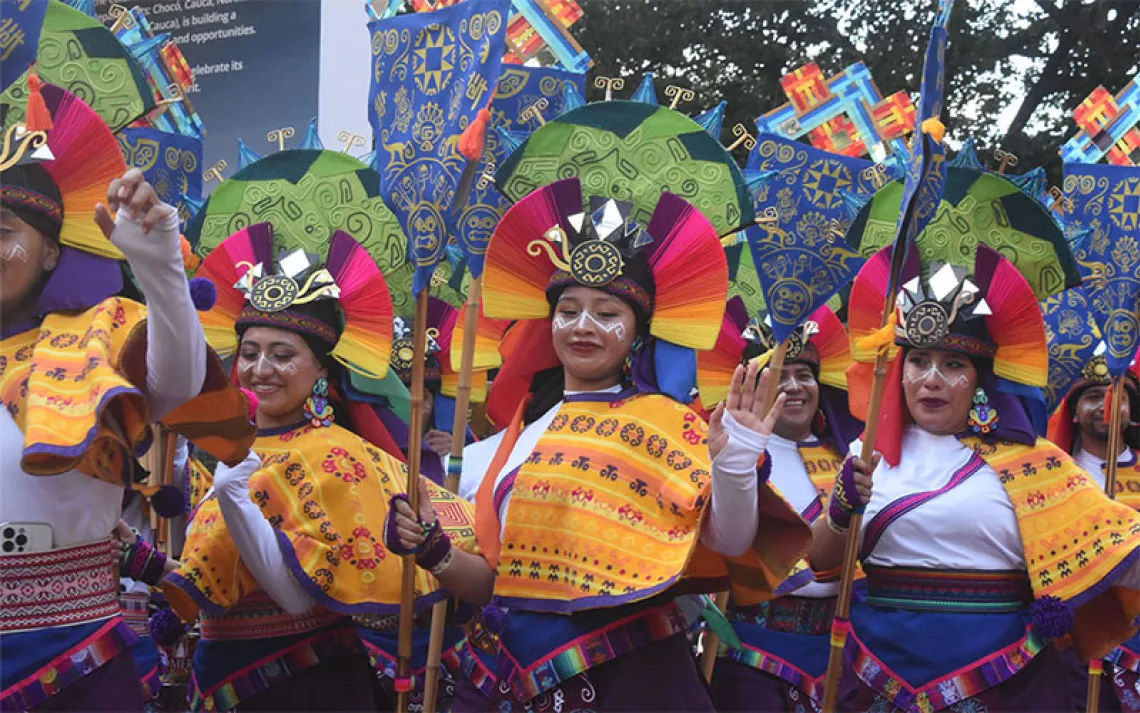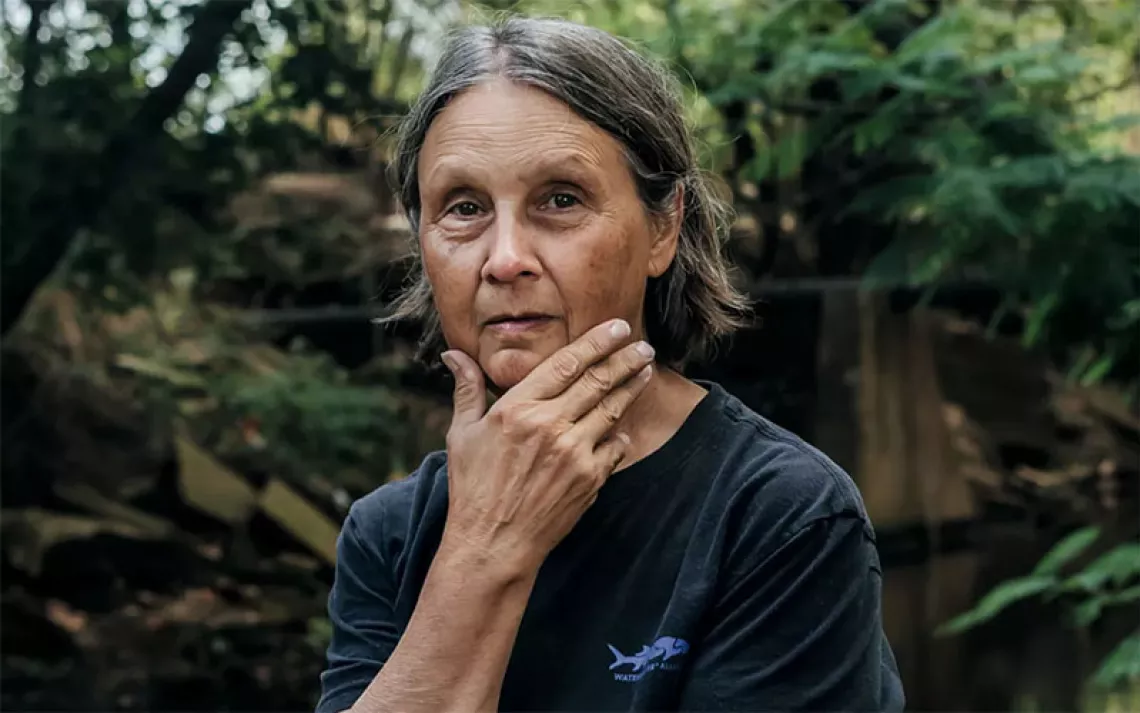A Postcard From the Red Road to DC
Traditionally carved totem pole brings attention to Indigenous sovereignty struggles across the United States

Photos courtesy of Wingspan Media
This article is a sneak peek from Sierra’s upcoming Fall edition. To become a print subscriber to Sierra, please become a Sierra Club member today.
The way the James brothers figure it, in the past 19 years they’ve driven the equivalent of three trips around the planet in the course of bringing their traditionally carved totem poles across North America.
First, there were the three poles dedicated to the September 11 attacks, one of which today stands in the Congressional Cemetery. Then in 2014, the sixty-something brothers—Douglas, the eldest, and Jewell, the master artist of the Lummi Nation’s House of Tears carvers—made a totem pole that they delivered to Alberta, Canada, to help fight tar sands extractions. The next year, they made another to resist a coal-export terminal on their traditional lands in the northwesternmost corner of Washington State. In 2018, they hauled one to the Miami Seaquarium to try to liberate an orca, Tokitae, which had been captured in Lummi traditional waters.
One early morning in mid-July, the Jameses and a 15-person entourage gathered in the parking lot of the Northwest Indian College to send their latest carving cross-continent. Strapped on a flatbed behind a rented Dodge Ram 3500 was their biggest creation ever: Just under 25 feet long, nearly 5,000 pounds, painted in red, white, black, and turquoise, and gilded with copper. Eighteen symbols had been carved into the 400-year-old cedar trunk. At the top was a full moon representing the circle of life, surrounded by red handprints to commemorate murdered and missing Indigenous women. A diving eagle’s head symbolized power. At the very bottom were running waters: the first medicine. “The rivers are drying up,” said Jewell, whose Indian name is Se-sealth. “They are just disappearing in our lifetime.”
The James brothers called this trip the Red Road to DC. The idea was to use the totem pole to bring attention to the many Native sovereignty struggles in the United States today. Among them are the fight to restore Bears Ears National Monument, the movement to protect sacred sites in Chaco Canyon from oil and gas drilling, and the resistance to the Line 3 Pipeline in the territory of the White Earth Ojibwe. After a late-July arrival in Washington, DC, where the work of art was to be received by Interior Secretary Deb Haaland, the pole would be placed on temporary display at the Smithsonian’s National Museum of the American Indian.
“We’ve witnessed this over 19 years, that coming together in unity and prayer can move mountains. It can stop coal trains. It can stop pipelines,” said Douglas, who also goes by Sit-Ki-Kadem. “They’re trying to take the last pieces of sacred land that we have, and they want to strip it and harvest everything in it.”


The caravan got on the road, and the totem pole soon passed through the coastal river lands of the Swinomish, the Stillaguamish, and the Duwamish peoples. Next, it went over the saw-toothed Cascades. On the east side of the mountain range, fir trees gave way to ponderosa, then the ponderosa surrendered to sagebrush. Wildfire smoke smudged the sky gray. The cool sea breezes of the Lummi Nation seemed a long way away.
The next day, the first official stop of the Red Road to DC was at Chief Timothy Park, on the Washington-Idaho border, where about 200 people gathered in a grove of sycamore and pine on the banks of the Snake River to call for tearing down the river’s dams. Less than seven generations ago, lamprey and salmon and steelhead by the millions swam here. Today, the lamprey are mostly gone, the local salmon are endangered, and the steelhead runs are at record lows.
For more than 20 years, the Nez Perce Nation (or Nimiipuu, as they refer to themselves) has called for removing the dams on the Snake. A recent proposal from Representative Mike Simpson, an Idaho Republican, to decommission four dams on the Lower Snake has now reinvigorated that effort. “Free the Snake River,” read a banner tied on the flatbed below the totem pole.
Sit-Ki-Kadem gave his standard stump speech. “Each and every one of us has an obligation to reach out and let your voice be heard—for those that don’t have a voice, the orcas and the salmon. If the land can heal, the people heal.”
The local Nez Perce hosts took the mic. “I recall the Snake before it became dammed,” said Silas Whitman (Tupluk’upsiimey), a former Nez Perce chairman. “The Snake was a beautiful river. It swirled in some places; in other places it was slow-moving with pools, lots of beaches.” He continued, “We lost all of those species because [federal government officials] thought they were providing a service to the public. We’ve had insult upon injury through the years.”
It was time to bless the totem pole. At most events, the James brothers ask people to come up and lay hands on the pole and then for others to put their hands on those folks, the crowd spiraling out like a human fractal, the pole acting like a kind of cultural radio antenna broadcasting inspiration. But the totem pole team felt pressed for time, and so instead they handed out cedar sprigs and invited people to quickly pass the pole and brush it with the cedar as they went by.
“Amazing,” said a blond high schooler from Boise, Idaho. “Heartrending and heartwarming,” said an older white woman from Pullman, Washington. “Really good medicine,” said a Klamath tribal member from Chiloquin, Oregon, who was there with a group of Native youths.
As the hosts handed out a lunch of fry bread and baked salmon, the totem pole team rushed to pack up and begin the two-day drive to Bears Ears in southern Utah. The thick ratchet straps went back over the carving. The rest of the gear went back into the truck bed. The caravan had to keep going.
Sit-Ki-Kadem climbed into the truck and fired up the engine. Even though they were running a bit behind schedule, he said that he felt “pretty good.” He had only another 3,850 miles to get to DC.
This article has been updated since publication.
 The Magazine of The Sierra Club
The Magazine of The Sierra Club



